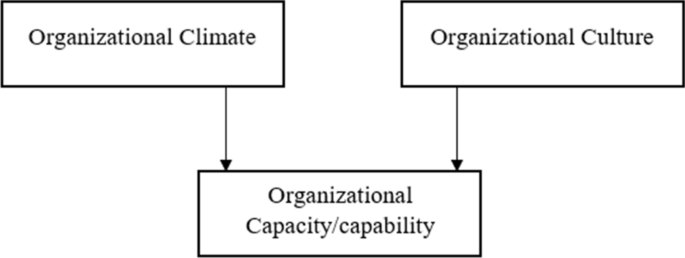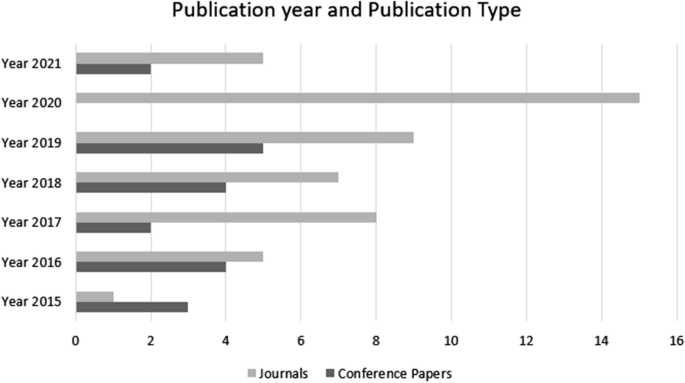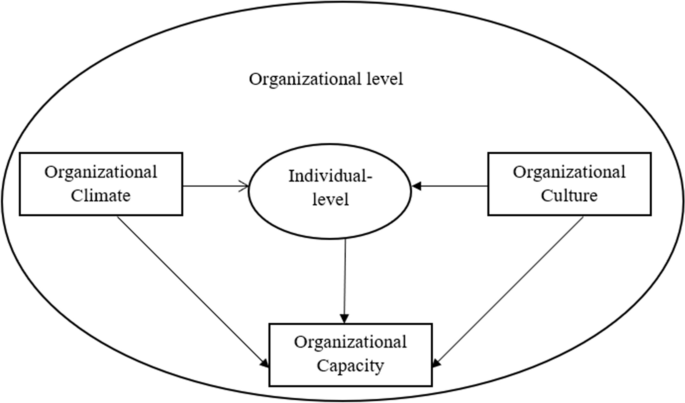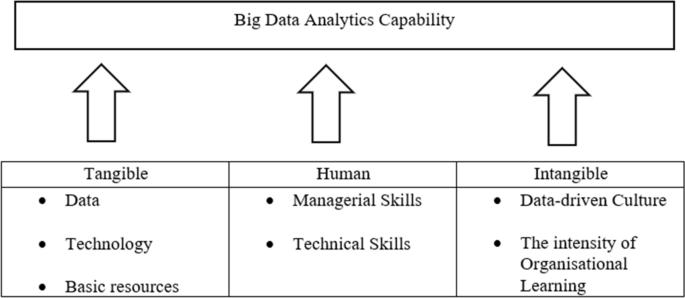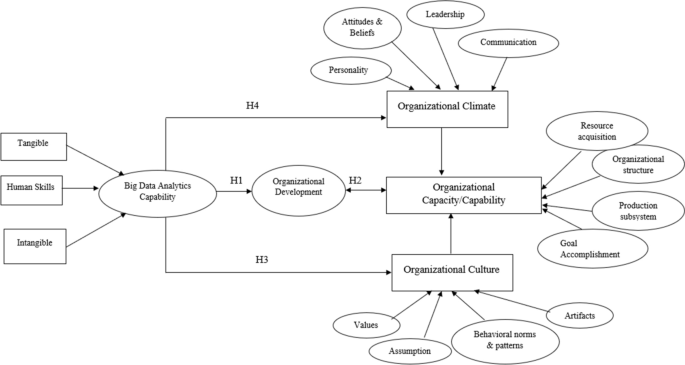- Survey Paper
- Open access
- Published:
A new theoretical understanding of big data analytics capabilities in organizations: a thematic analysis
Journal of Big Data volume 8, Article number: 159 (2021)
Abstract
Big Data Analytics (BDA) usage in the industry has been increased markedly in recent years. As a data-driven tool to facilitate informed decision-making, the need for BDA capability in organizations is recognized, but few studies have communicated an understanding of BDA capabilities in a way that can enhance our theoretical knowledge of using BDA in the organizational domain. Big Data has been defined in various ways and, the past literature about the classification of BDA and its capabilities is explored in this research. We conducted a literature review using PRISMA methodology and integrated a thematic analysis using NVIVO12. By adopting five steps of the PRISMA framework—70 sample articles, we generate five themes, which are informed through organization development theory, and develop a novel empirical research model, which we submit for validity assessment. Our findings improve effectiveness and enhance the usage of BDA applications in various Organizations.
Introduction
Organizations today continuously harvest user data [e.g., data collections] to improve their business efficiencies and practices. Significant volumes of stored data or data regarding electronic transactions are used in support of decision making, with managers, policymakers, and executive officers now routinely embracing technology to transform these abundant raw data into useful, informative information. Data analysis is complex, but one data-handling method, “Big Data Analytics” (BDA)—the application of advanced analytic techniques, including data mining, statistical analysis, and predictive modeling on big datasets as new business intelligence practice [1]—is widely applied. BDA uses computational intelligence techniques to transform raw data into information that can be used to support decision-making.
Because decision-making in organizations has become increasingly reliant on Big Data, analytical applications have increased in importance for evidence-based decision making [2]. The need for a systematic review of Big Data stream analysis using rigorous and methodical approaches to identify trends in Big Data stream tools, analyze techniques, technologies, and methods is becoming increasingly important [3]. Organizational factors such as organizational resources adjustment, environmental acceptance, and organizational management relate to implement its BDA capability and enhancing its benefits through BDA technologies [4]. It is evident from past literature that BDA supports the organizational decision-making process by developing suitable theoretical understanding, but extending existing theories remains a significant challenge. The improved capability of BDA will ensure that the organizational products and services are continuously optimized to meet the evolving needs of consumers.
Previous systematic reviews have focused on future BDA adoption challenges [5,6,7] or technical innovation aspects of Big Data analytics [8, 9]. This signifies those numerous studies have examined Big Data issues in different domains. These different domains are included: quality of Big Data in financial service organization [10]; organizational value creation because of BDA usage [11]; application of Big Data in health organizations [9]; decision improvement using Big Data in health [12]; application of Big Data in transport organizations [13]; relationships between Big Data in financial domains [14]; and quality of Big Data and its impact on government organizations [15].
While there has been a progressive increase in research on BDA, its capabilities and how organizations may exploit them are less well studied [16]. We apply a PRISMA framework [17]) and qualitative thematic analysis to create the model to define the relationship between BDAC and OD. The proposed research presents an overview of BDA capabilities and how they can be utilized by organizations. The implications of this research for future research development. Specifically, we (1) provide an observation into key themes regarding BDAC concerning state-of-the-art research in BDA, and (2) show an alignment to organizational development theory in terms of a new empirical research model which will be submitted for validity assessment for future research of BDAC in organizations.
According to [20], a systematic literature review first involves describing the key approach and establishing definitions for key concepts. We use a six-phase process to identify, analyze, and sequentially report themes using NVIVO 12.
Study background
Many forms of BDA exist to meet specific decision-support demands of different organizations. Three BDA analytical classes exist: (1) descriptive, dealing with straightforward questions regarding what is or has happened and why—with ‘opportunities and problems’ using descriptive statistics such as historical insights; (2) predictive, dealing with questions such as what will or is likely to happen, by exploring data patterns with relatively complex statistics, simulation, and machine-learning algorithms (e.g., to identify trends in sales activities, or forecast customer behavior and purchasing patterns); and (3) prescriptive, dealing with questions regarding what should be happening and how to influence it, using complex descriptive and predictive analytics with mathematical optimization, simulation, and machine-learning algorithms (e.g., many large-scale companies have adopted prescriptive analytics to optimize production or solve schedule and inventory management issues) [18]. Regardless of the type of BDA analysis performed, its application significantly impacts tangible and intangible resources within an organization.
Previous studies on BDA
BDA tools or techniques are used to analyze Big Data (such as social media or substantial transactional data) to support strategic decision-making [19] in different domains (e.g., tourism, supply chain, healthcare), and numerous studies have developed and evaluated BDA solutions to improve organizational decision support. We categorize previous studies into two main groups based on non-technical aspects: those which relate to the development of new BDA requirements and functionalities in a specific problem domain and those which focus on more intrinsic aspects such as BDAC development or value-adding because of their impact on particular aspects of the business. Examples of reviews focusing on technical or problem-solving aspects are detailed in Table 1.
The second literature group examines BDA in an organizational context, such as improving firm performance using Big Data analytics in specific business domains [26]. Studies that support BDA lead to different aspects of organizational performance [20, 24, 25, 27,28,29] (Table 2). Another research on BDA to improve data utilization and decision-support qualities. For example, [30] explained how BDAC might be developed to improve managerial decision-making processes, and [4] conducted a thematic analysis of 15 firms to identify the factors related to the success of BDA capability development in SCM.
Potential applications of BDA
Many retail organizations use analytical approaches to gain commercial advantage and organizational success [31]. Modern organizations increasingly invest in BDA projects to reduce costs, make accurate decision making, and future business planning. For example, Amazon was the first online retailer and maintained its innovative BDA improvement and use [31]. Examples of successful stories of BDA use in business sectors include.
-
Retail: business organizations using BDA for dynamic (surge) pricing [32] to adjust product or service prices based on demand and supply. For instance, Amazon uses dynamic pricing to surge prices by product demand.
-
Hospitality: Marriott hotels—the largest hospitality agent with a rapidly increasing number of hotels and serviced customers—uses BDA to improve sales [33].
-
Entertainment: Netflix uses BDA to retain clientele and increase sales and profits [34, 35].
-
Transportation: Uber uses BDA [36] to capture Big Data from various consumers and identify the best routes to locations. ‘Uber eats,’ despite competing with other delivery companies, delivers foods in the shortest possible time.
-
Foodservice: McDonald's continuously updates information with BDA, following a recent shift in food quality, now sells healthy food to consumers [37], and has adopted a dynamic menu [38].
-
Finance: American Express has used BDA for a long time and was one of the first companies to understand the benefits of using BDA to improve business performance [39]. Big Data is collected on the ways consumers make on- and offline purchases, and predictions are made as to how they will shop in the future.
-
Manufacturing: General Electric manufactures and distributes products such as wind turbines, locomotives, airplane engines, and ship engines [40]. By dealing with a huge amount of data from electricity networks, meteorological information systems, geographical information systems, benefits can be brought to the existing power system, including improving customer service and social welfare in the era of big data.
-
Online business: music streaming websites are increasingly popular and continue to grow in size and scope because consumers want a customized streaming service [41]. Many streaming services (e.g., Apple Music, Spotify, Google Music) use various BDA applications to suggest new songs to consumers.
Organization value assessment with BDA
Specific performance measures must be established that rely on the number of organizational contextual factors such as the organization's goal, the external environment of the organization, and the organization itself. When looking at the above contexts regarding the use of BDA to strengthen process innovation skills, it is important to note that the approach required to achieve positive results depends on the different combinations along with the area in which BDA deployed [42].
Organizational development and BDA
To assist organization decision-making for growth, effective processes are required to perform operations such as continuous diagnosis, action planning, and the implementation and evaluation of BDA. Lewin’s Organizational Development (OD) theory regards processes as having a goal to transfer knowledge and skills to an organization, with the process being mainly to improve problem-solving capacity and to manage future change. Beckhard [43] defined OD as the internal dynamics of an organization, which involve a collection of individuals working as a group to improve organizational effectiveness, capability, work performance, and the ability to adjust culture, policies, practices, and procedure requirements.
OD is ‘a system-wide application and transfer of behavioral science knowledge to the planned development, improvement, and reinforcement of the strategies, structures, and processes that lead to organization effectiveness’ [44], and has three concepts: organizational climate, culture, and capability [45]. Organizational climate is ‘the mood or unique personality of an organization’ [45] which includes shared perceptions of policies, practices, and procedures; climate features also consist of leadership, communication, participative management, and role clarity. Organizational culture involves shared basic assumptions, values, norms, behavioral patterns, and artifacts, defined by [46] as a pattern of shared basic assumptions that a group learned by solving problems of external adaptation and internal integration (p. 38). Organizational capacity (OC) implies the organization's function, such as the production of services or products or maintenance of organizational operations, and has four components: resource acquisition, organization structure, production subsystem, and accomplishment [47]. Organizational culture and climate affect an organization’s capacity to operate adequately (Fig. 1).
Framework of modified organizational development theory [45]
Research methodology
Our systematic literature review presents a research process for analyzing and examining research and gathering and evaluating it [48] In accordance with a PRISMA framework [49]. We use keywords to search for articles related to the BDA application, following a five-stage process.
Stage1: design development
We establish a research question to instruct the selection and search strategy and analysis and synthesis process, defining the aim, scope, and specific research goals following guidelines, procedures, and policies of the Cochrane Handbook for Systematic Reviews of Intervention [50]. The design review process is directed by the research question: what are the consistent definitions of BDA, unique attributes, objections, and business revolution, including improving the decision-making process and organization performance with BDA? The below table is created using the outcome of the search performed using Keywords- Organizational BDAC, Big Data, BDA (Table 3).
Stage 2: inclusion and elimination criteria
To maintain the nuances of a systematic review, we apply various inclusion and exclusion criteria to our search for research articles in four databases: Science Direct, Web of Science, IEEE (Institute of Electrical and Electronics Engineers), and Springer Link. Inclusion criteria include topics on ‘Big Data in Organization’ published between 2015 to 2021, in English. We use essential keywords to identify the most relevant articles, using truncation, wildcarding, and appropriate Boolean operators (Table 4).
Stage 3: literature sources and search approach
Research articles are excluded based on keywords and abstracts, after which 8062 are retained (Table 5). The articles only selected keywords such as Big Data, BDA, BDAC, and the Abstract only focused on the Organizational domain.
Stage 4: assess the quality of full papers
At this stage, for each of the 161 research articles that remained after stage 3 presented in Table 6, which was assessed independently by authors in terms of several quality criteria such as credibility, to assess whether the articles were well presented, relevance which was assessed based on whether the articles were used in the organizational domain.
Stage 5: literature extraction and synthesis process
At this stage, only journal articles and conference papers are selected. Articles for which full texts were not open access were excluded, reducing our references to 70 papersFootnote 1 (Table 7).
Meta-analysis of selected papers
Of the 70 papers satisfying our selection criteria, publication year and type (journal or conference paper) reveal an increasing trend in big data analytics over the last 6 years (Table 6). Additionally, journals produced more BDA papers than Conference proceedings (Fig. 2), which may be affected during 2020–2021 because of COVID, and fewer conference proceedings or publications were canceled.
Of the 70 research articles, 6% were published in 2015, 13% (2016), 14% (2017), 16% (2018), 20% (2019), 21% (2020), and 10% (untill May 2021).
Results
Thematic analysis is used to find the results which can identify, analyze and report patterns (themes) within data, and produce an insightful analysis to answer particular research questions [51].
The combination of NVIVO and Thematic analysis improves results. Judger [52] maintained that using computer-assisted data analysis coupled with manual checks improves findings' trustworthiness, credibility, and validity (p. 6).
Defining big data
Of 70 articles, 33 provide a clear replicable definition of Big Data, from which the five representative definitions are presented in Table 8.
Defining BDA
Of 70 sample articles, 21 clearly define BDA. The four representative definitions are presented in Table 9. Some definitions accentuate the tools and processes used to derive new insights from big data.
Defining Big Data analytics capability
Only 16% of articles focus on Big Data characteristics; one identifies challenges and issues with adopting and implementing the acquisition of Big Data in organizations [42]. The above study resulted that BDAC using the large volumes of data generated through different devices and people to increase efficiency and generate more profits. BDA capability and its potential value could be more than a business expects, which has been presented that the professional services, manufacturing, and retail have structural barriers and overcome these barriers with the use of Big Data [60]. We define BDAC as the combined ability to store, process, and analyze large amounts of data to provide meaningful information to users. Four dimensions of BDAC exist data integration, analytical, predictive, and data interpretation (Table 10).
BDA themes
It is feasible to identify outstanding issues of research that are of excessive relevance, which has termed in five themes using NVIVO12 (Fig. 3). Table 11 illustrates four units that combine NVIVO with thematic analysis for analysis: Big data, BDA, BDAC, and BDA themes. We manually classify five BDA themes to ensure accuracy with appropriate perception in detail and provide suggestions on how future researchers might approach these problems using a research model.
Manyika et al. [63] considered that BDA could assist an organization to improve its decision making, minimize risks, provide other valuable insights that would otherwise remain hidden, aid the creation of innovative business models, and improve performance.
The five themes presented in Table 11 identify limitations of existing literature, which are examined in our research model (Fig. 4) using four hypotheses. This theoretical model identifies organizational and individual levels as being influenced by organization climate, culture, and capacity. This model can assist in understanding how BDA can be used to improve organizational and individual performance.
The framework of organizational development theory [64]
The Research model development process
We analyze literature using a new research method, driven by the connection between BDAC and resource-based views, which included three resources: tangible (financial and physical), human skills (employees’ knowledge and skills), and intangible (organizational culture and organizational learning) used in IS capacity literature [65,66,67,68]. Seven factors enable firms to create BDAC [16] (Fig. 5).
Classification of Big Data resources (adapted from [16])
To develop a robust model, tangible, intangible, and human resource types should be implemented in an organization and contribute to the emergence of the decision-making process. This research model recognizes BDAC to enhance OD, strengthening organizational strategies and the relationship between BD resources and OD. Figure 6 depicts a theoretical framework illustrating how BDA resources influence innovation sustainability and OD, where Innovation sustainability helps identify market opportunities, predict customer needs, and analyze customer purchase decisions [69].
Theroretical framework illustrating how BDA resources influence innovation sustainability and organizational development (adapted from [68])
Miller [70] considered data a strategic business asset and recommended that businesses and academics collaborate to improve knowledge regarding BD skills and capability across an organization; [70] concluded that every profession, whether business or technology, will be impacted by big data and analytics. Gobble [71] proposed that an organization should develop new technologies to provide necessary supplements to enhance growth. Big Data represents a revolution in science and technology, and a data-rich smart city is the expected future that can be developed using Big Data [72]. Galbraith [73] reported how an organization attempting to develop BDAC might experience obstacles and opportunities. We found no literature that combined Big Data analytics capability and Organizational Development or discussed interaction between them.
Because little empirical evidence exists regarding the connection between OD and BDA or their characteristics and features, our model (Fig. 7) fills an important void, directly connecting BDAC and OD, and illustrates how it affects OD in the organizational concepts of capacity, culture, and climate, and their future resources. Because BDAC can assist OD through the implementation of new technologies [15, 26, 57], we hypothesize:
H1: A positive relationship exists between Organizational Development and BDAC.
OC relies heavily on OD, with OC representing a resource requiring development in an organization. Because OD can improve OC [44, 45], we hypothesize that:
H2: A positive relationship exists between Organizational Development and Organizational Capability.
With the implementation or adoption of BDAC, OC is impacted [46]. Big data enables an organization to improve inefficient practices, whether in marketing, retail, or media. We hypothesize that:
H3: A positive relationship exists between BDAC and Organizational Culture.
Because BDAC adoption can affect OC, the policies, practices, and measures associated with an organization's employee experience [74], and improve both the business climate and an individual’s performance, we hypothesize that:
H4: A positive relationship exists between BDAC and Organizational Climate.
Our research is based on a need to develop a framework model in relation to OD theory because modern organizations cannot ignore BDA or its future learning and association with theoretical understanding. Therefore, we aim to demonstrate current trends in capabilities and a framework to improve understanding of BDAC for future research.
Discussion
Despite the hype that encompasses Big Data, the organizational development and structure through which it results in competitive gains have remained generally underexplored in empirical studies. It is feasible to distinguish the five prominent, highly relevant themes discussed in an earlier section by orchestrating a systematic literature review and recording what is known to date. By conducting those five thematic areas of the research, as depicted in the research model in Fig. 7, provide relation how they are impacting each other’s performance and give some ideas on how researchers could approach these problems.
The number of published papers on Big Data is increasing. Between 2015 and May 2021, the highest proportion of journal articles for any given year (21%) occurred until May 2021 with the inclusion or exclusion criteria such as the article selection only opted using four databases: Science Direct, Web of Science, IEEE (Institute of Electrical and Electronics Engineers), and Springer Link and included only those articles which titled as 'Big Data in Organization' published, in the English language. We use essential keywords to identify the most relevant articles, using truncation, wildcarding, and appropriate Boolean operators. While BDAC can improve business-related outcomes, including more effective marketing, new revenue opportunities, customer personalization, and improved operational efficiency, existing literature has focused on only one or two aspects of BDAC. Our research model (Fig. 7) represents the relationship between BDAC and OD to better understand their impacts on OC. We explain that the proposed model education will enhance knowledge of BDAC and that it may better meet organizational requirements, ensuring improved products and services to optimize consumer outcomes.
Considerable research has been conducted in many different contexts such as the health sector, education about Big Data, but according to past literature, BDAC in an organization is still an open issue, how to utilize BDAC within the organization for development purposes. The full potential of BDA and what it can offer must be leveraged to gain a commercial advantage. Therefore, we focus on summarizing by creating the themes using past relevant literature and propose a research model based on literature [61] for business.
While we explored Springer Link, IEEE, Science Direct, and Web of Science (which index high-impact journal and conference papers), the possibility exists that some relevant journals were missed. Our research is constrained by our selection criteria, including year, language (English), and peer-reviewed journal articles (we omitted reports, grey journals, and web articles).
Conclusion
A steadily expanding number of organizations has been endeavored to utilize Big Data and organizational analytics to analyze available data and assist with decision-making. For these organizations, influence the full potential that Big Data and organizational analytics can present to acquire competitive advantage. In any case, since Big Data and organizational analytics are generally considered as new innovative in business worldview, there is a little exploration on how to handle them and leverage them adequately. While past literature has shown the advantages of utilizing Big Data in various settings, there is an absence of theoretically determined research on the most proficient method to use these solutions to acquire competitive advantage. This research recognizes the need to explore BDA through a comprehensive approach. Therefore, we focus on summarizing with the proposed development related to BDA themes on which we still have a restricted observational arrangement.
To this end, this research proposes a new research model that relates earlier studies regarding BDAC in organizational culture. The research model provides a reference to the more extensive implementation of Big Data technologies in an organizational context. While the hypothesis present in the research model is on a significant level and can be deciphered as addition to theoretical lens, they are depicted in such a way that they can be adapted for organizational development. This research poses an original point of view on Big Data literature since, by far majority focuses on tools, infrastructure, technical aspects, and network analytics. The proposed framework contributes to Big Data and its capability in organizational development by covering the gap which has not addressed in past literature. This research model also can be viewed as a value-adding knowledge for managers and executives to learn how to drive channels of creating benefit in their organization through the use of Big Data, BDA, and BDAC.
We identify five themes to leverage BDA in an organization and gain a competitive advantage. We present a research model and four hypotheses to bridge gaps in research between BDA and OD. The purpose of this model and these hypotheses is to guide research to improve our understanding of how BDA implementation can affect an organization. The model goes for the next phase of our study, in which we will test the model for its validity.
Availability of data and materials
Data will be supplied upon request.
Notes
Appendix A is submitted as a supplementary file for review.
Abbreviations
- IEEE:
-
The Institute of Electrical and Electronics Engineers
- BD:
-
Big Data
- BDA:
-
Big Data Analytics
- BDAC:
-
Big Data Analytics Capabilities
- OD:
-
Organizational Development
- OC:
-
Organizational Capacity
References
Russom P. Big data analytics. TDWI Best Practices Report, Fourth Quarter. 2011;19(4):1–34.
Mikalef P, Boura M, Lekakos G, Krogstie J. Big data analytics and firm performance: findings from a mixed-method approach. J Bus Res. 2019;98:261–76.
Kojo T, Daramola O, Adebiyi A. Big data stream analysis: a systematic literature review. J Big Data. 2019;6(1):1–30.
Jha AK, Agi MA, Ngai EW. A note on big data analytics capability development in supply chain. Decis Support Syst. 2020;138:113382.
Posavec AB, Krajnović S. Challenges in adopting big data strategies and plans in organizations. In: 2016 39th international convention on information and communication technology, electronics and microelectronics (MIPRO). IEEE. 2016. p. 1229–34.
Madhlangobe W, Wang L. Assessment of factors influencing intent-to-use Big Data Analytics in an organization: pilot study. In: 2018 IEEE 20th International Conference on High-Performance Computing and Communications; IEEE 16th International Conference on Smart City; IEEE 4th International Conference on Data Science and Systems (HPCC/SmartCity/DSS). IEEE. 2018. p. 1710–1715.
Saetang W, Tangwannawit S, Jensuttiwetchakul T. The effect of technology-organization-environment on adoption decision of big data technology in Thailand. Int J Electr Comput. 2020;10(6):6412. https://doi.org/10.11591/ijece.v10i6.pp6412-6422.
Pei L. Application of Big Data technology in construction organization and management of engineering projects. J Phys Conf Ser. 2020. https://doi.org/10.1088/1742-6596/1616/1/012002.
Marashi PS, Hamidi H. Business challenges of Big Data application in health organization. In: Khajeheian D, Friedrichsen M, Mödinger W, editors. Competitiveness in Emerging Markets. Springer, Cham; 2018. p. 569–584. doi:https://doi.org/10.1007/978-3-319-71722-7_28.
Haryadi AF, Hulstijn J, Wahyudi A, Van Der Voort H, Janssen M. Antecedents of big data quality: an empirical examination in financial service organizations. In 2016 IEEE International Conference on Big Data (Big Data). IEEE. 2016. p. 116–121.
George JP, Chandra KS. Asset productivity in organisations at the intersection of Big Data Analytics and supply chain management. In: Chen JZ, Tavares J, Shakya S, Iliyasu A, editors. Image Processing and Capsule Networks. ICIPCN 2020. Advances in Intelligent Systems and Computing, vol 1200. Springer, Cham; 2020. p. 319–330.
Sousa MJ, Pesqueira AM, Lemos C, Sousa M, Rocha Á. Decision-making based on big data analytics for people management in healthcare organizations. J Med Syst. 2019;43(9):1–10.
Du G, Zhang X, Ni S. Discussion on the application of big data in rail transit organization. In: Wu TY, Ni S, Chu SC, Chen CH, Favorskaya M, editors. International conference on smart vehicular technology, transportation, communication and applications. Springer: Cham; 2018. p. 312–8.
Wahyudi A, Farhani A, Janssen M. Relating big data and data quality in financial service organizations. In: Al-Sharhan SA, Simintiras AC, Dwivedi YK, Janssen M, Mäntymäki M, Tahat L, Moughrabi I, Ali TM, Rana NP, editors. Conference on e-Business, e-Services and e-Society. Springer: Cham; 2018. p. 504–19.
Alkatheeri Y, Ameen A, Isaac O, Nusari M, Duraisamy B, Khalifa GS. The effect of big data on the quality of decision-making in Abu Dhabi Government organisations. In: Sharma N, Chakrabati A, Balas VE, editors. Data management, analytics and innovation. Springer: Singapore; 2020. p. 231–48.
Gupta M, George JF. Toward the development of a big data analytics capability. Inf Manag. 2016;53(8):1049–64.
Selçuk AA. A guide for systematic reviews: PRISMA. Turk Arch Otorhinolaryngol. 2019;57(1):57.
Tiwari S, Wee HM, Daryanto Y. Big data analytics in supply chain management between 2010 and 2016: insights to industries. Comput Ind Eng. 2018;115:319–30.
Miah SJ, Camilleri E, Vu HQ. Big Data in healthcare research: a survey study. J Comput Inform Syst. 2021;7:1–3.
Mikalef P, Pappas IO, Krogstie J, Giannakos M. Big data analytics capabilities: a systematic literature review and research agenda. Inf Syst e-Business Manage. 2018;16(3):547–78.
Nguyen T, Li ZHOU, Spiegler V, Ieromonachou P, Lin Y. Big data analytics in supply chain management: a state-of-the-art literature review. Comput Oper Res. 2018;98:254–64.
Günther WA, Mehrizi MHR, Huysman M, Feldberg F. Debating big data: a literature review on realizing value from big data. J Strateg Inf. 2017;26(3):191–209.
Rialti R, Marzi G, Ciappei C, Busso D. Big data and dynamic capabilities: a bibliometric analysis and systematic literature review. Manag Decis. 2019;57(8):2052–68.
Wamba SF, Gunasekaran A, Akter S, Ren SJ, Dubey R, Childe SJ. Big data analytics and firm performance: effects of dynamic capabilities. J Bus Res. 2017;70:356–65.
Wang Y, Hajli N. Exploring the path to big data analytics success in healthcare. J Bus Res. 2017;70:287–99.
Akter S, Wamba SF, Gunasekaran A, Dubey R, Childe SJ. How to improve firm performance using big data analytics capability and business strategy alignment? Int J Prod Econ. 2016;182:113–31.
Kwon O, Lee N, Shin B. Data quality management, data usage experience and acquisition intention of big data analytics. Int J Inf Manage. 2014;34(3):387–94.
Chen DQ, Preston DS, Swink M. How the use of big data analytics affects value creation in supply chain management. J Manag Info Syst. 2015;32(4):4–39.
Kim MK, Park JH. Identifying and prioritizing critical factors for promoting the implementation and usage of big data in healthcare. Inf Dev. 2017;33(3):257–69.
Popovič A, Hackney R, Tassabehji R, Castelli M. The impact of big data analytics on firms’ high value business performance. Inf Syst Front. 2018;20:209–22.
Hewage TN, Halgamuge MN, Syed A, Ekici G. Big data techniques of Google, Amazon, Facebook and Twitter. J Commun. 2018;13(2):94–100.
BenMark G, Klapdor S, Kullmann M, Sundararajan R. How retailers can drive profitable growth through dynamic pricing. McKinsey & Company. 2017. https://www.mckinsey.com/industries/retail/our-insights/howretailers-can-drive-profitable-growth-throughdynamic-pricing. Accessed 13 Mar 2021.
Richard B. Hotel chains: survival strategies for a dynamic future. J Tour Futures. 2017;3(1):56–65.
Fouladirad M, Neal J, Ituarte JV, Alexander J, Ghareeb A. Entertaining data: business analytics and Netflix. Int J Data Anal Inf Syst. 2018;10(1):13–22.
Hadida AL, Lampel J, Walls WD, Joshi A. Hollywood studio filmmaking in the age of Netflix: a tale of two institutional logics. J Cult Econ. 2020;45:1–26.
Harinen T, Li B. Using causal inference to improve the Uber user experience. Uber Engineering. 2019. https://eng.uber.com/causal-inference-at-uber/. Accessed 10 Mar 2021.
Anaf J, Baum FE, Fisher M, Harris E, Friel S. Assessing the health impact of transnational corporations: a case study on McDonald’s Australia. Glob Health. 2017;13(1):7.
Wired. McDonald's Bites on Big Data; 2019. https://www.wired.com/story/mcdonalds-big-data-dynamic-yield-acquisition
Bernard M. & Co. American Express: how Big Data and machine learning Benefits Consumers And Merchants, 2018. https://www.bernardmarr.com/default.asp?contentID=1263
Zhang Y, Huang T, Bompard EF. Big data analytics in smart grids: a review. Energy Informatics. 2018;1(1):8.
HBS. Next Big Sound—moneyball for music? Digital Initiative. 2020. https://digital.hbs.edu/platform-digit/submission/next-big-sound-moneyball-for-music/. Accessed 10 Apr 2021.
Mneney J, Van Belle JP. Big data capabilities and readiness of South African retail organisations. In: 2016 6th International Conference-Cloud System and Big Data Engineering (Confluence). IEEE. 2016. p. 279–86.
Beckhard R. Organizational issues in the team delivery of comprehensive health care. Milbank Mem Fund. 1972;50:287–316.
Cummings TG, Worley CG. Organization development and change. 8th ed. Mason: Thompson South-Western; 2009.
Glanz K, Rimer BK, Viswanath K, editors. Health behavior and health education: theory, research, and practice. San Francisco: Wiley; 2008.
Schein EH. Organizational culture and leadership. San Francisco: Jossey-Bass; 1985.
Prestby J, Wandersman A. An empirical exploration of a framework of organizational viability: maintaining block organizations. J Appl Behav Sci. 1985;21(3):287–305.
Liberati A, Altman DG, Tetzlaff J, Mulrow C, Gøtzsche PC, Ioannidis JP, Moher D. The PRISMA statement for reporting systematic reviews and meta-analyses of studies that evaluate health care interventions: explanation and elaboration. J Clin Epidemiol. 2009;62(10):e1–34.
Page MJ, McKenzie JE, Bossuyt PM, Boutron I, Hoffmann TC, Mulrow CD, Moher D. The PRISMA 2020 statement: an updated guideline for reporting systematic reviews. BMJ. 2021;372:n71.
Higgins JP, Green S, Scholten RJPM. Maintaining reviews: updates, amendments and feedback. Cochrane handbook for systematic reviews of interventions. 31; 2008.
Braun V, Clarke V. Using thematic analysis in psychology. Qual Res Psychol. 2006;3(2):77–101.
Judger N. The thematic analysis of interview data: an approach used to examine the influence of the market on curricular provision in Mongolian higher education institutions. Hillary Place Papers, University of Leeds. 2016;3:1–7
Khine P, Shun W. Big data for organizations: a review. J Comput Commun. 2017;5:40–8.
Zan KK. Prospects for using Big Data to improve the effectiveness of an education organization. In: 2019 IEEE Conference of Russian Young Researchers in Electrical and Electronic Engineering (EIConRus). IEEE. 2019. p. 1777–9.
Ekambaram A, Sørensen AØ, Bull-Berg H, Olsson NO. The role of big data and knowledge management in improving projects and project-based organizations. Procedia Comput Sci. 2018;138:851–8.
Rialti R, Marzi G, Silic M, Ciappei C. Ambidextrous organization and agility in big data era: the role of business process management systems. Bus Process Manag. 2018;24(5):1091–109.
Wang Y, Kung L, Gupta S, Ozdemir S. Leveraging big data analytics to improve quality of care in healthcare organizations: a configurational perspective. Br J Manag. 2019;30(2):362–88.
De Mauro A, Greco M, Grimaldi M, Ritala P. In (Big) Data we trust: value creation in knowledge organizations—introduction to the special issue. Inf Proc Manag. 2018;54(5):755–7.
Batistič S, Van Der Laken P. History, evolution and future of big data and analytics: a bibliometric analysis of its relationship to performance in organizations. Br J Manag. 2019;30(2):229–51.
Jokonya O. Towards a conceptual framework for big data adoption in organizations. In: 2015 International Conference on Cloud Computing and Big Data (CCBD). IEEE. 2015. p. 153–160.
Mikalef P, Krogstie J, Pappas IO, Pavlou P. Exploring the relationship between big data analytics capability and competitive performance: the mediating roles of dynamic and operational capabilities. Inf Manag. 2020;57(2):103169.
Shuradze G, Wagner HT. Towards a conceptualization of data analytics capabilities. In: 2016 49th Hawaii International Conference on System Sciences (HICSS). IEEE. 2016. p. 5052–64.
Manyika J, Chui M, Brown B, Bughin J, Dobbs R, Roxburgh C, Hung Byers A. Big data: the next frontier for innovation, competition, and productivity. McKinsey Global Institute. 2011. https://www.mckinsey.com/business-functions/mckinsey-digital/our-insights/big-data-the-next-frontier-for-innovation. Accessed XX(day) XXX (month) XXXX (year).
Wu YK, Chu NF. Introduction of the transtheoretical model and organisational development theory in weight management: a narrative review. Obes Res Clin Pract. 2015;9(3):203–13.
Grant RM. Contemporary strategy analysis: Text and cases edition. Wiley; 2010.
Bharadwaj AS. A resource-based perspective on information technology capability and firm performance: an empirical investigation. MIS Q. 2000;24(1):169–96.
Chae HC, Koh CH, Prybutok VR. Information technology capability and firm performance: contradictory findings and their possible causes. MIS Q. 2014;38:305–26.
Santhanam R, Hartono E. Issues in linking information technology capability to firm performance. MIS Q. 2003;27(1):125–53.
Hao S, Zhang H, Song M. Big data, big data analytics capability, and sustainable innovation performance. Sustainability. 2019;11:7145. https://doi.org/10.3390/su11247145.
Miller S. Collaborative approaches needed to close the big data skills gap. J Organ Des. 2014;3(1):26–30.
Gobble MM. Outsourcing innovation. Res Technol Manag. 2013;56(4):64–7.
Ann Keller S, Koonin SE, Shipp S. Big data and city living–what can it do for us? Signif (Oxf). 2012;9(4):4–7.
Galbraith JR. Organizational design challenges resulting from big data. J Organ Des. 2014;3(1):2–13.
Schneider B, Ehrhart MG, Macey WH. Organizational climate and culture. Annu Rev Psychol. 2013;64:361–88.
Acknowledgements
Not applicable
Funding
Not applicable.
Author information
Authors and Affiliations
Contributions
The first author conducted the research, while the second author has ensured quality standards and rewritten the entire findings linking to underlying theories. All authors read and approved the final manuscript.
Corresponding author
Ethics declarations
Ethics approval and consent to participate
Not applicable
Consent for publication
Not applicable
Competing interests
The authors declare that they have no competing interests.
Additional information
Publisher's Note
Springer Nature remains neutral with regard to jurisdictional claims in published maps and institutional affiliations.
Rights and permissions
Open Access This article is licensed under a Creative Commons Attribution 4.0 International License, which permits use, sharing, adaptation, distribution and reproduction in any medium or format, as long as you give appropriate credit to the original author(s) and the source, provide a link to the Creative Commons licence, and indicate if changes were made. The images or other third party material in this article are included in the article's Creative Commons licence, unless indicated otherwise in a credit line to the material. If material is not included in the article's Creative Commons licence and your intended use is not permitted by statutory regulation or exceeds the permitted use, you will need to obtain permission directly from the copyright holder. To view a copy of this licence, visit http://creativecommons.org/licenses/by/4.0/.
About this article
Cite this article
Sabharwal, R., Miah, S.J. A new theoretical understanding of big data analytics capabilities in organizations: a thematic analysis. J Big Data 8, 159 (2021). https://doi.org/10.1186/s40537-021-00543-6
Received:
Accepted:
Published:
DOI: https://doi.org/10.1186/s40537-021-00543-6
